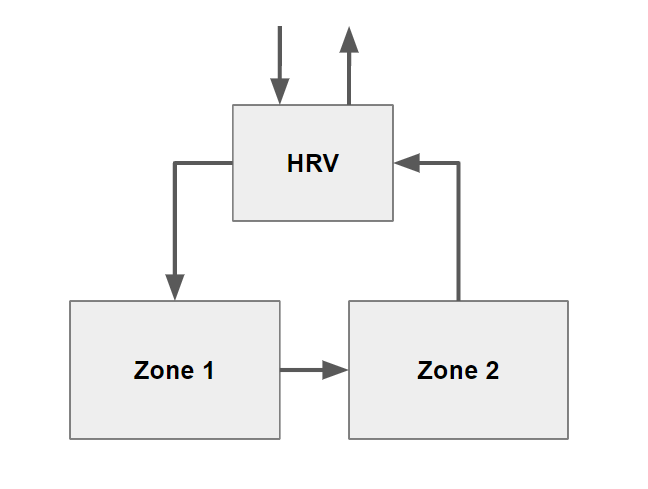Transfer air and heat recovery / Passive house
I'm modelling a small building that has supply air directly to some zones, transfer air to the rest, and extraction from all zones - which then goes through an HRV. I want to keep rooms as separate zones in order to model some comfort issues that have come up.
The current model is in Energy Plus. I could create a full network manually, just hoping to find a faster way. Any suggestions for how to model this with HVAC templates? Perhaps with some editing of the expanded IDF? Would Open Studio have better tools for this type of model?
The building has similarities to a passive house (supply air in some zones, return from others). How are those typically modeled with E+ / OS?
EDIT:
The simplest form would be something like this (this just shows the general flow, not all elements of the air loop). I now have a model of this that seems to work where I created a duct branch from the Zone 1 return air node to the Zone 2 air inlet node. The CO2 concentrations are as expected (much higher in Zone 2), but the air temp is almost the same in the two zones so I'm trying to isolate other factors.







@max.melchiorthis post should answer your question about modeling transfer air processes in EnergyPlus using inter-zone mixing and zone exhaust fans. OpenStudio can do this, but the zone mixing part would be through the Add Zone Mixing measure. You can read more about that in this post. These posts also discuss your final question about supply/return calculations in EnergyPlus, but you could search for other posts as well.
Thanks. I think I figured out the air transfer and exhaust, and it behaves as I would expect when looking at CO2 levels and temperature. I just haven't found an easy way to send the exhaust air back through the DOAS system and the HRV, so the energy calcs are off. I'm having to model energy use in a separate model where I connect the DOAS to each zone in the usual way.
I'm still curious how to model a simple passive house HVAC in EnergyPlus, with OA entering some zones and exiting from others into an HRV.
@max.melchior could you include a diagram of this airflow that you want to model in EnergyPlus? Is the HRV recovering heat between the outgoing central exhaust and the incoming central outdoor air as part of the DOAS?
I've added a simplified diagram in the original post. In my model the HRV is connected to the outdoor air system like you mentioned.